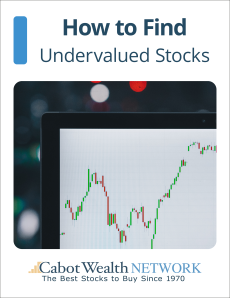By Bruce Kaser, Chief Analyst, Cabot Value Investor and Cabot Turnaround Letter
How to Find Undervalued Stocks
I love stock investing. It’s interesting, exciting and potentially lucrative. It can also be quite risky. I’ve been investing in stocks since 1988, and over the decades, I’ve learned to identify the factors that push stock prices up, and the factors that can lead to stocks going through bearish phases. In simple terms, value is a good descriptive word for my investment strategy. But what is value?
To me, value refers to potential capital gain opportunity in the stock market. Value stocks are stocks with strong balance sheets, good earnings growth, and low price-to-earnings ratios (P/Es). They’re screened to eliminate layers of risk, so that all that’s left for us is glowing opportunity.
Let’s break that down and look at a value stock’s four components.
[text_ad]
Components of a Value Stock
Earnings per share (EPS) growth: Over the medium and long term, earnings growth drives share price growth. You definitely want to focus on stocks with earnings growth. Sure, a stock can rise if the company has stagnant or falling earnings—or even annual losses. But the stock that’s most likely to rise is the stock with growing earnings. My stock selections are expected to grow earnings per share (EPS) by 15% or more, both in the current year and in the next fiscal year.
Investors can look at Wall Street’s consensus earnings estimates to determine EPS growth rates.
Caveat: I don’t go by prior years’ EPS. I’m looking toward the future, so I use future EPS.
Price/earnings ratio (P/E): I want the stock’s current P/E to be lower than the EPS growth rate. If a company is expected to grow earnings by 18% this year but the P/E is 24, I would consider that stock to be overvalued and I would ignore it. But if the P/E were 12, that would catch my eye!
I’ll also look at the next fiscal year’s P/E compared to next year’s EPS growth rate. There’s no point in buying a stock that’s undervalued based on this year’s earnings, if it’s overvalued based on next year’s earnings. (That situation arises when this year’s earnings growth rate is expected to be quite a bit higher than next year’s earnings growth rate.)
There are nuances to the P/E ratio. Many stocks have typical annual P/E ranges, which can provide valuable info on whether the stock is undervalued compared to its normal trading patterns. And industry groups also have typical P/E ranges. One way or another, a stock with a P/E that’s low compared to its normal range, or low compared to its earnings growth rate, is going to be an undervalued stock!
Dividend yield: If dividends are important to you, but you also want capital gains, here’s a good approach. Add the EPS growth rate to the dividend yield, e.g., 12% + 3% = 15. In that example, you will want the P/E to be lower than 15 when you’re screening for undervalued stocks. If the P/E is 14, I’m not going to get excited about buying the stock. But if the P/E is 11, you’re looking at a good potential capital gain opportunity.
Long-term debt-to-capitalization ratio: I focus on stocks with debt ratios below 40%. Simply put, high debt levels can strangle a company’s ability to invest, innovate and compete.
If the stock passes my earnings, P/E and debt screens, then I look at the stock’s chart. I want the chart to be somewhat bullish. I want to buy stocks that appear ready to rise; not stocks that are falling, stagnating, or those that just experienced a huge run-up.
Certainly, there’s an art to reading stock charts. I’m happy to tell subscribers to my Cabot Undervalued Stocks Advisor newsletter which stocks pass my valuation screens, and what their charts are indicating regarding near-term and medium-term price movement.
The Benjamin Graham Approach
Benjamin Graham’s value investing approach is another one we’ve modeled here at Cabot over the years.
Graham is considered the father of value investing, introducing his detailed approach to finding value stocks in his 1934 book, “Security Analysis.” But it was Graham’s second book, “The Intelligent Investor,” that still resonates today, serving as a veritable Bible for many a modern-day value investor, including Warren Buffett.
So what is it that made Graham’s work so special?
In short, he systematized the entire process of evaluating companies, all with the goal of finding low-risk (or no-risk) investments that would reward over the long run.
Graham liked to analyze–and quantify–a business according to six factors.
1. Profitability
2. Stability
3. Growth in earnings
4. Financial position
5. Dividends
6. Price history
One of Benjamin Graham’s favorite parables is that of Mr. Market, who Graham often referred to in the classes he taught at Columbia University as well several times in “The Intelligent Investor.”
Graham’s Mr. Market is a fellow who turns up every day at the stock holder’s door offering to buy or sell his shares at a different price. Often, the price quoted by Mr. Market seems plausible, but sometimes, it is ridiculous. The investor is free to either agree with his quoted price and trade with him, or to ignore him completely. Mr. Market doesn’t mind this, and will be back the following day to quote another price.
Graham’s point is that the investor should not regard the whims of Mr. Market as determining the value of the shares that the investor owns. He should profit from market folly rather than participate in it. The investor is best off concentrating on the real-life performance of his companies and their dividends, rather than being too concerned with Mr. Market’s often irrational behavior.
Here’s an excerpt from “The Intelligent Investor,” page 204-205:
“Imagine that in some private business you own a small share that cost you $1,000. One of your partners, named Mr. Market, is very obliging indeed. Every day he tells you what he thinks your interest is worth and furthermore offers either to buy you out or to sell you an additional interest on that basis. Sometimes his idea of value appears plausible and justified by business developments and prospects as you know them. Often, on the other hand, Mr. Market lets his enthusiasm or his fears run away with him, and the value he proposes seems to you a little short of silly.
“If you are a prudent investor or a sensible businessman, will you let Mr. Market’s daily communication determine your view of the value of a $1,000 interest in the enterprise? Only in case you agree with him, or in case you want to trade with him. You may be happy to sell out to him when he quotes you a ridiculously high price, and equally happy to buy from him when his price is low. But the rest of the time you will be wiser to form your own ideas of the value of your holdings, based on full reports from the company about its operations and financial position.
“The true investor is in that very position when he owns a listed common stock. He can take advantage of the daily market price or leave it alone, as dictated by his own judgment and inclination. He must take cognizance of important price movements, for otherwise his judgment will have nothing to work on. Conceivably they may give him a warning signal which he will do well to heed—this in plain English means that he is to sell his shares because the price has gone down, foreboding worse things to come. In our view such signals are misleading at least as often as they are helpful.
“Basically, price fluctuations have only one significant meaning for the true investor. They provide him with an opportunity to buy wisely when prices fall sharply and to sell wisely when they advance a great deal. At other times he will do better if he forgets about the stock market and pays attention to his dividend returns and to the operating results of his companies.”
Sage advice.
The Last Word on Undervalued Stocks
While much of what Benjamin Graham wrote 75 years ago still holds true in today’s value investing world, I have modernized the approach in many ways.
Mine is both a growth strategy and a value strategy. The growth component is reflected in the stringent EPS growth rate requirement. The value component is reflected in the P/E and debt requirements.
I know that there are many perceptions of what “value” means in the investment world. Some people think value means low share prices or poor stock charts or simply big lumbering blue chip companies with big dividends and a lack of earnings growth. But to me, value means a strong balance sheet, and a share price that will attract both institutional buyers and M&A buyout offers.
One of the important reasons that my stock selection process is so stringent is that the numbers are constantly changing after the stocks are added to my portfolios. If the earnings growth rates decline due to a slowing business cycle, or the P/Es increase due to rising share prices, I want to have enough wiggle room so that the stock remains undervalued and attractive.
Over the years, my growth-and-value approach has been successful.
My biggest winners include +50% in PulteGroup in nine months, +53% in Goldman Sachs in 12 months, +34% in Moline Healthcare in three months, and +36% in Applied Materials in five months—to name a few. If you’d like to hear about what undervalued stocks I’m recommending today, click here to subscribe to my Cabot Value Investor. You won’t be disappointed!

